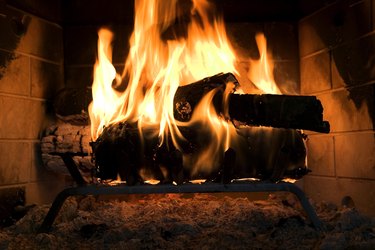
When wood burns in a stove or fireplace, it gives off combustion byproducts such as smoke, ash and wood particles. As air currents carry these contaminants away from the fire, they settle as soot or creosote deposits in the fire compartment, stove pipe or chimney. These deposits are harmful when they block airflow or catch fire at a later time.
Creosote
Video of the Day
Creosote is a tarry residue that condenses from wood or coal particles, hydrocarbons, gases and other airborne debris. These substances stick to the surface as they cool, forming layers of flammable deposits. Creosote may be dry and crackling to the touch, thick and flaky layers or shiny and hardened black gooey substances. Creosote forms as gases cool, so deposits occur when chimney temperatures are cool and when air is not hot enough to carry the particles out of the chimney. Restricted air supply also allows the sticky particles to settle.
Video of the Day
Soot
Soot is a powdery residue of unburned carbon particles. The soot, usually brown or black, is like a dust or smudgy smoke that settles on surfaces. At first, soot can be easily brushed or wiped off. But it gradually accumulates in layers in chimneys, fireplaces and stovepipes. Soot deposits may accumulate over time and reduce airflow up to 30 percent so that the flue does not vent properly. This may cause smoke to back up in a home and cause health problems.
Removal
Regular chimney or stovepipe maintenance is the most reliable way to remove creosote and soot. The deposits are scrubbed off with chimney scrubbers or stovepipe brushes. Stovepipes may be disassembled for cleaning, but brick chimneys are fixed and typically cleaned by scrubbing downward with a chimney brush from the roof and upward from the firebox with a wire brush. Homeowners are sometimes tempted to build a hot fire to burn out the creosote deposits. This is not wise because the creosote may burn as an extremely hot fire in the chimney and damage the chimney and house structure.
Tips
Select well-seasoned hardwood as firewood. It burns at a hot, steady temperature to encourage complete combustion and strong air circulation. When starting a fire, hold a burning kindling stick or wad of newspaper at the open flue. This heats the air so that creosote and soot are carried up the hot airflow where they're less likely to settle in the chimney. Clean the chimney or stovepipe regularly. And check the damper to ensure smooth operation and efficient airflow. Use a chimney cap to keep out leaves, wildlife, bird nests and other accumulations that block airflow.
- eXtension: Using Combustion Heat for Energy
- Purdue University: Residential Wood Stove Installation
- University of Georgia Extension: Prevent Chimney Fires
- University of Missouri: Wood Stove Maintenance and Operation
- University of Missouri: Cleaning Stovepipes and Chimneys
- Michigan State University: Chimney Problems